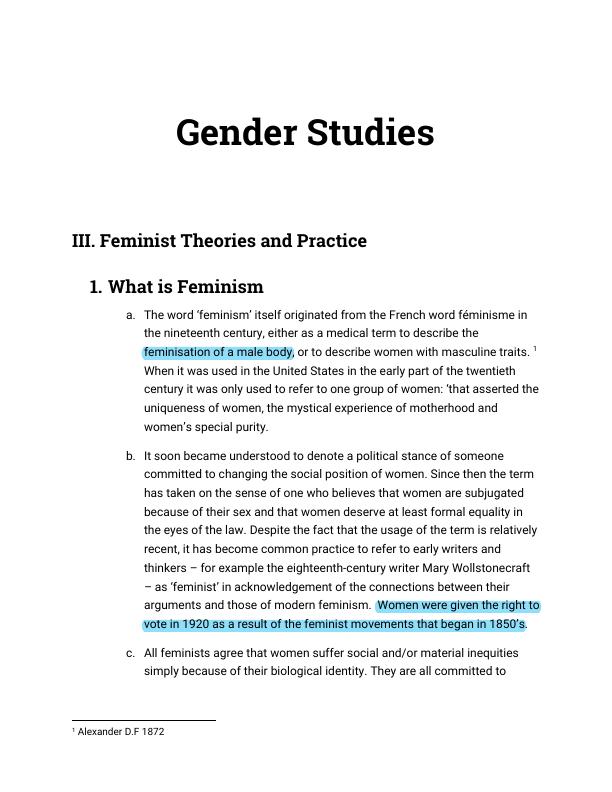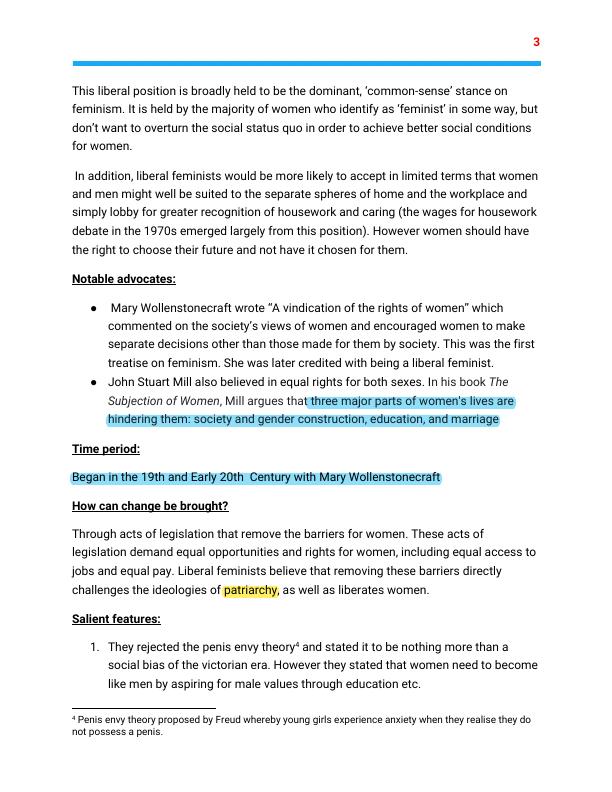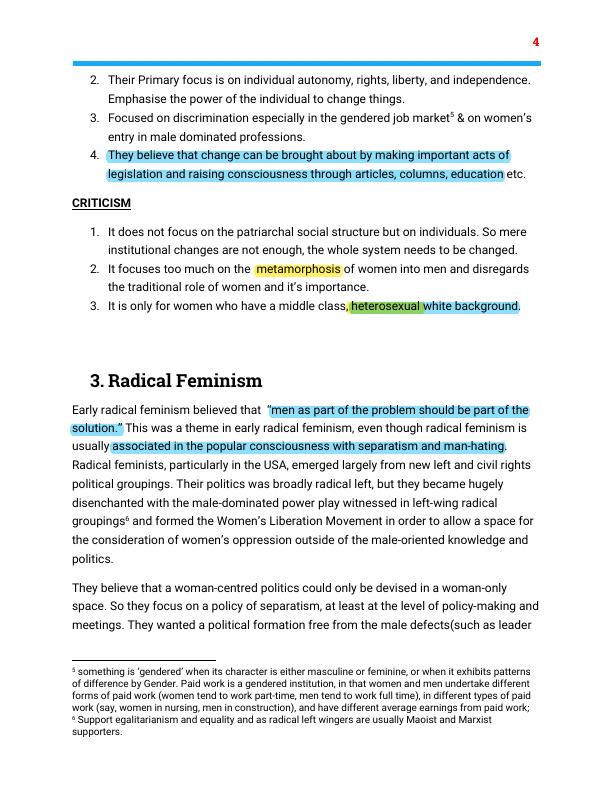Feminist Theories and Practice | Gender Studies
Added on 2022-09-08
11 Pages3577 Words15 Views
Gender Studies
III. Feminist Theories and Practice
1. What is Feminism
a. The word ‘feminism’ itself originated from the French word féminisme in
the nineteenth century, either as a medical term to describe the
feminisation of a male body, or to describe women with masculine traits. 1
When it was used in the United States in the early part of the twentieth
century it was only used to refer to one group of women: ‘that asserted the
uniqueness of women, the mystical experience of motherhood and
women’s special purity.
b. It soon became understood to denote a political stance of someone
committed to changing the social position of women. Since then the term
has taken on the sense of one who believes that women are subjugated
because of their sex and that women deserve at least formal equality in
the eyes of the law. Despite the fact that the usage of the term is relatively
recent, it has become common practice to refer to early writers and
thinkers – for example the eighteenth-century writer Mary Wollstonecraft
– as ‘feminist’ in acknowledgement of the connections between their
arguments and those of modern feminism. Women were given the right to
vote in 1920 as a result of the feminist movements that began in 1850’s.
c. All feminists agree that women suffer social and/or material inequities
simply because of their biological identity. They are all committed to
1 Alexander D.F 1872
III. Feminist Theories and Practice
1. What is Feminism
a. The word ‘feminism’ itself originated from the French word féminisme in
the nineteenth century, either as a medical term to describe the
feminisation of a male body, or to describe women with masculine traits. 1
When it was used in the United States in the early part of the twentieth
century it was only used to refer to one group of women: ‘that asserted the
uniqueness of women, the mystical experience of motherhood and
women’s special purity.
b. It soon became understood to denote a political stance of someone
committed to changing the social position of women. Since then the term
has taken on the sense of one who believes that women are subjugated
because of their sex and that women deserve at least formal equality in
the eyes of the law. Despite the fact that the usage of the term is relatively
recent, it has become common practice to refer to early writers and
thinkers – for example the eighteenth-century writer Mary Wollstonecraft
– as ‘feminist’ in acknowledgement of the connections between their
arguments and those of modern feminism. Women were given the right to
vote in 1920 as a result of the feminist movements that began in 1850’s.
c. All feminists agree that women suffer social and/or material inequities
simply because of their biological identity. They are all committed to
1 Alexander D.F 1872
development of female sexual characteristics

2
challenging this idea, but they differ in the way they propose to challenge
it.
d. Feminist Ideas:
i. They describe and define the relationship of nature of gender and
inequality. This includes discrimination, stereotyping,
objectification, oppression and patriarchy
ii. Feminist ideas champion the rights of women.
iii. They negate the biblical representation of women as weak
characters and discourage biological destiny.2
iv. They focus on women’s oppression & how to overcome it to
promote equality b/w men & women; politically, economically and
socially.
2. Liberal Feminism
Liberal feminism draws on the diversity of liberal thought dominant in Western society
since the Enlightenment, and affirms that women’s subordinate social position can be
addressed by existing political processes under democracy.
They believe that women should be given the same opportunities in political, economic,
educational and and that they have the same mental capacity as men. For liberals the
key battle is access to education because if men and women are educated equally, then
it follows that they will get equal access to society. Liberal feminists do not use the3
language of ‘revolution’ or ‘liberation’ favoured by radicals and socialists. They believe
that democracy itself is naturally adaptable to equality for both sexes. It is based on
individualism which states that all humans have same rational nature and share same
values.
2 This is the idea that human society and behavior are to some significant degree determined
by our biological inheritance. So biological destiny of females is to reproduce.
3 Essentially, women must be like men. (John F.Kennedy)
challenging this idea, but they differ in the way they propose to challenge
it.
d. Feminist Ideas:
i. They describe and define the relationship of nature of gender and
inequality. This includes discrimination, stereotyping,
objectification, oppression and patriarchy
ii. Feminist ideas champion the rights of women.
iii. They negate the biblical representation of women as weak
characters and discourage biological destiny.2
iv. They focus on women’s oppression & how to overcome it to
promote equality b/w men & women; politically, economically and
socially.
2. Liberal Feminism
Liberal feminism draws on the diversity of liberal thought dominant in Western society
since the Enlightenment, and affirms that women’s subordinate social position can be
addressed by existing political processes under democracy.
They believe that women should be given the same opportunities in political, economic,
educational and and that they have the same mental capacity as men. For liberals the
key battle is access to education because if men and women are educated equally, then
it follows that they will get equal access to society. Liberal feminists do not use the3
language of ‘revolution’ or ‘liberation’ favoured by radicals and socialists. They believe
that democracy itself is naturally adaptable to equality for both sexes. It is based on
individualism which states that all humans have same rational nature and share same
values.
2 This is the idea that human society and behavior are to some significant degree determined
by our biological inheritance. So biological destiny of females is to reproduce.
3 Essentially, women must be like men. (John F.Kennedy)

3
This liberal position is broadly held to be the dominant, ‘common-sense’ stance on
feminism. It is held by the majority of women who identify as ‘feminist’ in some way, but
don’t want to overturn the social status quo in order to achieve better social conditions
for women.
In addition, liberal feminists would be more likely to accept in limited terms that women
and men might well be suited to the separate spheres of home and the workplace and
simply lobby for greater recognition of housework and caring (the wages for housework
debate in the 1970s emerged largely from this position). However women should have
the right to choose their future and not have it chosen for them.
Notable advocates:
● Mary Wollenstonecraft wrote “A vindication of the rights of women” which
commented on the society’s views of women and encouraged women to make
separate decisions other than those made for them by society. This was the first
treatise on feminism. She was later credited with being a liberal feminist.
● John Stuart Mill also believed in equal rights for both sexes. In his book The
Subjection of Women, Mill argues that three major parts of women's lives are
hindering them: society and gender construction, education, and marriage
Time period:
Began in the 19th and Early 20th Century with Mary Wollenstonecraft
How can change be brought?
Through acts of legislation that remove the barriers for women. These acts of
legislation demand equal opportunities and rights for women, including equal access to
jobs and equal pay. Liberal feminists believe that removing these barriers directly
challenges the ideologies of patriarchy, as well as liberates women.
Salient features:
1. They rejected the penis envy theory and stated it to be nothing more than a4
social bias of the victorian era. However they stated that women need to become
like men by aspiring for male values through education etc.
4 Penis envy theory proposed by Freud whereby young girls experience anxiety when they realise they do
not possess a penis.
This liberal position is broadly held to be the dominant, ‘common-sense’ stance on
feminism. It is held by the majority of women who identify as ‘feminist’ in some way, but
don’t want to overturn the social status quo in order to achieve better social conditions
for women.
In addition, liberal feminists would be more likely to accept in limited terms that women
and men might well be suited to the separate spheres of home and the workplace and
simply lobby for greater recognition of housework and caring (the wages for housework
debate in the 1970s emerged largely from this position). However women should have
the right to choose their future and not have it chosen for them.
Notable advocates:
● Mary Wollenstonecraft wrote “A vindication of the rights of women” which
commented on the society’s views of women and encouraged women to make
separate decisions other than those made for them by society. This was the first
treatise on feminism. She was later credited with being a liberal feminist.
● John Stuart Mill also believed in equal rights for both sexes. In his book The
Subjection of Women, Mill argues that three major parts of women's lives are
hindering them: society and gender construction, education, and marriage
Time period:
Began in the 19th and Early 20th Century with Mary Wollenstonecraft
How can change be brought?
Through acts of legislation that remove the barriers for women. These acts of
legislation demand equal opportunities and rights for women, including equal access to
jobs and equal pay. Liberal feminists believe that removing these barriers directly
challenges the ideologies of patriarchy, as well as liberates women.
Salient features:
1. They rejected the penis envy theory and stated it to be nothing more than a4
social bias of the victorian era. However they stated that women need to become
like men by aspiring for male values through education etc.
4 Penis envy theory proposed by Freud whereby young girls experience anxiety when they realise they do
not possess a penis.
domainance over women

4
2. Their Primary focus is on individual autonomy, rights, liberty, and independence.
Emphasise the power of the individual to change things.
3. Focused on discrimination especially in the gendered job market & on women’s5
entry in male dominated professions.
4. They believe that change can be brought about by making important acts of
legislation and raising consciousness through articles, columns, education etc.
CRITICISM
1. It does not focus on the patriarchal social structure but on individuals. So mere
institutional changes are not enough, the whole system needs to be changed.
2. It focuses too much on the metamorphosis of women into men and disregards
the traditional role of women and it’s importance.
3. It is only for women who have a middle class, heterosexual white background.
3. Radical Feminism
Early radical feminism believed that “men as part of the problem should be part of the
solution.” This was a theme in early radical feminism, even though radical feminism is
usually associated in the popular consciousness with separatism and man-hating.
Radical feminists, particularly in the USA, emerged largely from new left and civil rights
political groupings. Their politics was broadly radical left, but they became hugely
disenchanted with the male-dominated power play witnessed in left-wing radical
groupings and formed the Women’s Liberation Movement in order to allow a space for6
the consideration of women’s oppression outside of the male-oriented knowledge and
politics.
They believe that a woman-centred politics could only be devised in a woman-only
space. So they focus on a policy of separatism, at least at the level of policy-making and
meetings. They wanted a political formation free from the male defects(such as leader
5 something is ‘gendered’ when its character is either masculine or feminine, or when it exhibits patterns
of difference by Gender. Paid work is a gendered institution, in that women and men undertake different
forms of paid work (women tend to work part-time, men tend to work full time), in different types of paid
work (say, women in nursing, men in construction), and have different average earnings from paid work;
6 Support egalitarianism and equality and as radical left wingers are usually Maoist and Marxist
supporters.
2. Their Primary focus is on individual autonomy, rights, liberty, and independence.
Emphasise the power of the individual to change things.
3. Focused on discrimination especially in the gendered job market & on women’s5
entry in male dominated professions.
4. They believe that change can be brought about by making important acts of
legislation and raising consciousness through articles, columns, education etc.
CRITICISM
1. It does not focus on the patriarchal social structure but on individuals. So mere
institutional changes are not enough, the whole system needs to be changed.
2. It focuses too much on the metamorphosis of women into men and disregards
the traditional role of women and it’s importance.
3. It is only for women who have a middle class, heterosexual white background.
3. Radical Feminism
Early radical feminism believed that “men as part of the problem should be part of the
solution.” This was a theme in early radical feminism, even though radical feminism is
usually associated in the popular consciousness with separatism and man-hating.
Radical feminists, particularly in the USA, emerged largely from new left and civil rights
political groupings. Their politics was broadly radical left, but they became hugely
disenchanted with the male-dominated power play witnessed in left-wing radical
groupings and formed the Women’s Liberation Movement in order to allow a space for6
the consideration of women’s oppression outside of the male-oriented knowledge and
politics.
They believe that a woman-centred politics could only be devised in a woman-only
space. So they focus on a policy of separatism, at least at the level of policy-making and
meetings. They wanted a political formation free from the male defects(such as leader
5 something is ‘gendered’ when its character is either masculine or feminine, or when it exhibits patterns
of difference by Gender. Paid work is a gendered institution, in that women and men undertake different
forms of paid work (women tend to work part-time, men tend to work full time), in different types of paid
work (say, women in nursing, men in construction), and have different average earnings from paid work;
6 Support egalitarianism and equality and as radical left wingers are usually Maoist and Marxist
supporters.
people who want to have sex with someone who has the different sex
a great change in apperance or character

End of preview
Want to access all the pages? Upload your documents or become a member.
Related Documents
Encyclopedia of Critical Psychologylg...
|8
|2394
|11
Comparing Approaches to Women's Rights in Wollstonecraft's Vindication of the Rights of Women and Beauvior's The Second Sexlg...
|9
|1698
|127
Gender and Social Inequalitylg...
|10
|3380
|386
Radical feminism Article 2022lg...
|7
|1506
|24
Feminist Theorylg...
|7
|2016
|46
Changing Perspectives on Genderlg...
|12
|3480
|208
